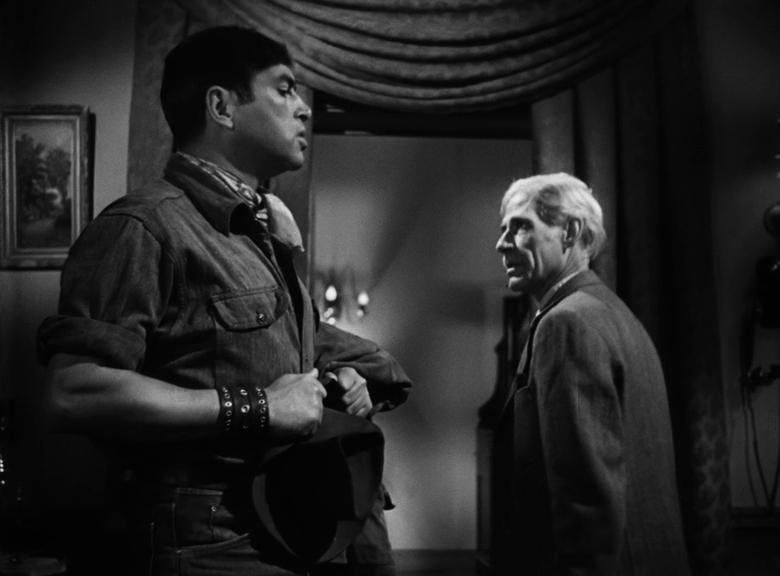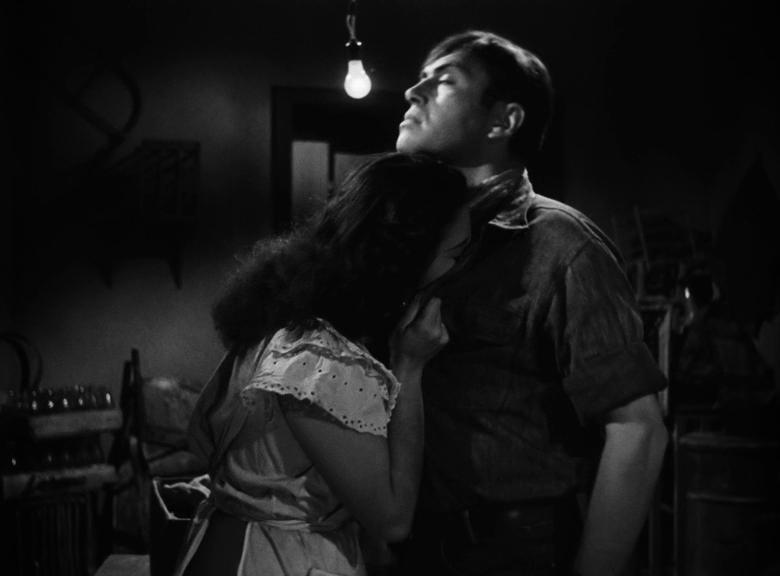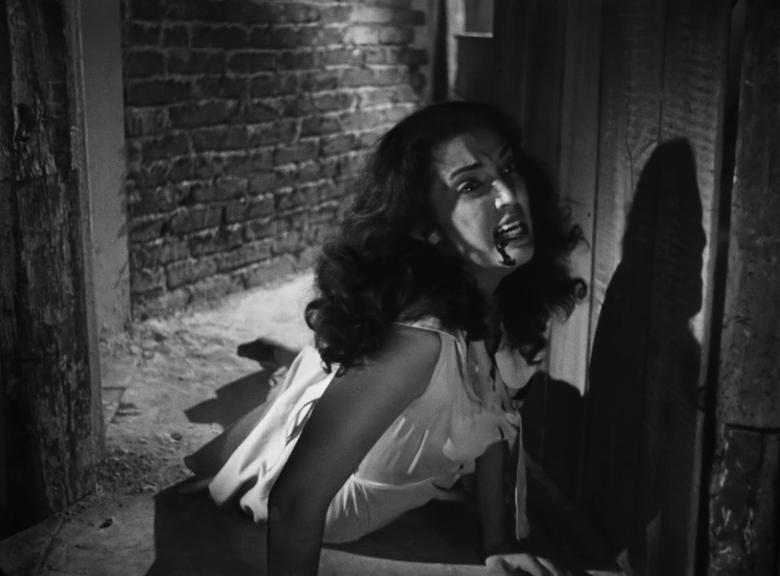Director: Luis Buñuel
Writers: Luis Alcoriza and Luis Buñuel, based on a story by Luis Buñuel
Stars: Pedro Armendáriz, Katy Jurado, Rosita Arenas and Andrés Soler
 |
Index: 2024 Centennials.
Any opportunity I can get to watch a Luis Buñuel movie I’ll happily take and here’s one from his Mexican period that’s new to me. I know his early work as a surrealist, working with Salvador Dalí on films like Un Chien Andalou—yes, the one with the eyeball slice—and much of his later award-winning work, including The Exterminating Angel which I absolutely adore. However, it’s his mid-period work in Mexico that I tend to appreciate most, especially his exquisitely written melodramas that somehow avoid those scenes we all know were written specifically to win awards for actors. This may not have the depth of Los Olvidados, but it’s a tough story with some highly memorable characters, not only El Bruto himself, played by Pedro Armendáriz, one of the pivotal Latino actors of any country in the forties and fifties; but also Andrés Soler, one of the great Mexican actors from the era; and our first centenarian for 2024, Katy Jurado, who plays a real piece of work here who is responsible for most of what happens in the film.
She may not be responsible for the initial plot device, which is a landlord telling the tenants of a block of flats he owns that they’re all being evicted. He’s Andrés Cabrera, clearly a well off gentleman but one eager to get the 150,000 pesos he’s been offered for the land the flats sit on, which doesn’t make the news any easier for his tenants. Times are hard, not so much that they can’t pay their rent but enough that they struggle to make ends meet otherwise, the diet being whatever they can afford and their health affected by whether they can pay for medicine or not. So they resist, a quartet of brave tenants speaking for them all when they dismiss the eviction notice and say that they’ll fight to stay. Given that the movie is called The Brute, it’s not hard to see that them standing up for their rights or even just what they perceive might be their rights will be dangerous. Señor Cabrera gives them twenty days. It’s pretty clear that they’ll ignore it.
 |
She’s certainly responsible for what happens next, because she’s the one who suggests a serious response to their effrontery. She’s Paloma, who’s Señor Cabrera’s trophy wife, beautiful and much younger than he is. Katy Jurado was born in 1924, of course, so she was twenty-eight when this was shot in 1952, but Andrés Soler was born in 1898, making him almost twice her age. We first see her taking care of housework and we never see them go anywhere you might expect a husband to take his trophy wife, so it’s not hard to imagine how frustrated she must be with the life she’s married into, however opulent it might seem to the tenants facing being thrown out onto the street. Not only does she raise that serious response, which is a brutal suggestion to come from a wife, but she even phrases it in such a way that personalises it. Who can help him? Surely he knows someone who can deliver a serious response in whatever form her husband might decide upon now that the seed has been planted in his mind.
And, of course, he does. He knows El Bruto, a powerfully built young man who works at a slaughterhouse. We learn later in the film that El Bruto’s real name is Pedro and Cabrera was like a father to him growing up because Pedro’s mother was his maid. However, he clearly sees this young man as a tool to be used rather than a son to be loved. Then again, Pedro has no ambition, content to let life happen to him, which is why he’s living with a girl, inevitably called Maria, and her family of annoying hangers on: her brother is a demanding scrounger, her mother is a demanding hypochondriac and her uncle is a demanding invalid. When Cabrera has him make his eviction problem go away by taking on the four troublemakers, starting with Señor Carmelo, he also tells him to leave his girl to live in a storage room at his butcher’s shop and leave the slaughterhouse too to work in that shop alongside Paloma, who’s a capable trophy wife. And he does, just like that. One chapter in life closed and another opened. No big deal.
 |
The initial scenes between Armendáriz and Jurado are fantastic, starting the moment she lets him in through the front door. She’s impressed immediately, even before she realises how strong he is and then she’s even more impressed. They’re well matched, both as actors and as characters, Paloma’s acerbic tongue and fearlessness a fair counter to Bruto’s imposing physicality. Naturally, he’s bigger and tougher, but she’s brighter and more strategic. Of course, she’s tough too. Not only does she feel free to speak her mind without filters and constantly belittle him while also flirting outrageously with him, but she escalates that in his room, sniffing her way up his chest and even biting it, only to then reject him when he responds exactly how we might expect. While we would never mess with someone called El Bruto just on principle, we clearly shouldn’t mess with Paloma either, because we’d likely end up in an equally problematic place, merely a different one.
The first man who does mess with one of these two characters is Señor Carmelo, after Bruto tracks him down on the street. He will not be threatened, he says, so Bruto punches him, just once, but that puts him down hard; we soon discover that, when neighbours carry him home, he was vomiting blood and he dies soon afterwards. Pedro also intimidates a lady carrying a baby, threatening to throw it against a wall if she doesn’t leave. Those are powerful messages and that lady promptly packs her bags. This picture isn’t a western, so the poor intimidated locals don’t pool their meagre resources to hire a gunslinger to take care of their battle for them, as we’ve seen a thousand times; they do it themselves by ganging up on Pedro on the street. One of them saw him in the butcher’s shop, so they gather their weapons and follow him and suddenly we’re in a beautifully shot film noir, as Pedro runs through what appears to be a lumber mill, these scenes claustrophobic and cleverly lit.
 |
There’s one primary character left to introduce and that’s the lady whose back yard he hides in and whose chicken he kills to stop it giving him away. She’s Meche Carmelo, played by a relative newcomer, Rosita Arenas, and that surname means exactly what you think it does. What’s interesting to me is that I know Armendáriz and Jurado, both Mexican actors, for their American pictures, but Arenas, who was Venezuelan, for her Mexican films, albeit for later exploitation movies like the Aztec Mummy trilogy. She’s a young and beautiful lady here but Meche is also quiet and innocent, not only because she’s mourning her father, so it’s not surprising that Pedro falls in love with her. Given that Paloma has fallen in lust with him, you can absolutely see where we’re going and, yes we do, merely with an agreeable level of viciousness that Katy Jurado was able to utterly nail. I thoroughly appreciated that these two are flipped from our expectations. Bruto is exactly that but he becomes sympathetic. Paloma, for all her beauty, is the real beast here.
El bruto is part of the Golden Age of Mexican Cinema, as indeed was Los Olvidados and many of Buñuel’s other Mexican films, but it’s a late entry. While we might think of Hollywood as a dominant force in cinema across the globe, it’s never had a monopoly and the American film output, especially during the years of the Production Code from 1934 to the late sixties, was notable for restrictions placed upon it. For more substantial films that tackled difficult issues or simply featured, as this did, lead characters who were not clearly good or bad and both won and lost the day, filmgoers needed the cinemas of other countries. Mexico had made substantial films ever since the advent of sound and very possibly before it, but its proximity to Hollywood meant that filmmakers had easy paths to learn and the shift in Europe in the thirties towards a war footing meant that there was a sizeable gap in Spanish language cinema that it could fill and filmmakers like Buñuel looking for a home. And so began its Golden Age in 1936, with Allá en el Rancho Grande.
 |
Pedro Armendáriz was a good part of that, with a string of movies for director Emilio Fernández, most notably María Candelaria and The Pearl. The former came out in 1943 with Armendáriz and Dolores del Río the leads in the first Mexican picture to be screened at Cannes, where it won a Grand Prix, the award now known as the Palme d’Or. The latter was released in 1947, based on a novella by John Steinbeck and co-produced by RKO, with Armendáriz and María Elena Marqués co-stars in the first Spanish language movie to win a Golden Globe, for cinematographer Gabriel Figueroa. By the time he made The Brute, Armendáriz had even crossed the border to appear in Hollywood films, invited by no less a name than John Ford, for whom he made The Fugitive, Fort Apache and 3 Godfathers, in the latter as one of the titular characters alongside John Wayne and Harry Carey, Jr. His last role was in From Russia with Love, the James Bond film, but he was so ill that his final scenes saw him doubled by director Terence Young.
Katy Jurado, born a hundred years ago today, was also part of that but less so, because she debuted in 1943 and spent a good part of the golden age in Hollywood. Notably, even though she was the first Latina actress to win a Golden Globe, for 1952’s High Noon, and the first to be nominated for an Oscar, for 1954’s Broken Lance, she refused to sign a long term contract with a Hollywood studio, so that she could continue to make films in Mexico. She foresaw, rather astutely, that any Hollywood career that she could get would likely include plenty of stereotypical roles and she didn’t want to become known for that or indeed for any one thing. So she made films in the States and she made films in Mexico and she’s accordingly remembered today for a dramatic range rather than for any particular type of role, rather unlike her predecessors, Dolores del Río and Lupe Vélez. Of course, she did live up to one stereotype, namely her fiery temper and passion, so she’s also remembered for plenty off screen too.
 |
She was born María Cristina Estela Marcela Jurado García in Mexico City, though her family always called her Katy, so Katy Jurado was an easy stage name when she took to acting. Her father, Luis Jurado Ochoa, was a lawyer and cattle rancher who owned orange groves. Her mother, Vicenta García, was an opera singer, working for the radio station XEW, the oldest such in Latin America. Her godfather, an important role in Mexican culture, was, drum roll please, Pedro Armendáriz. If that might suggest a comfortable life, it did and I should add that her cousin, Emilio Portes Gil, had been the Mexican President from 1928 to 1930. However, the Mexican Revolution prompted the loss of much of their fortune, so while she started out in life much more fortunate than most characters in El bruto, she still had to work for a living. She planned to study to be a lawyer but accepted an invitation to work in film, against the wishes of her family, by signing her first contract without their authorisation, presumably by forging their signatures.
Her debut was in No matarás in 1943, not as a lead but high up the credits list, and she consolidated on that with sixteen more films in the forties, before expanding her reach in the fifties when Budd Boetticher and John Wayne saw her at a bullfight. I should point out here that, in addition to her prolific screen work, she moonlighted by penning movie columns, reporting on radio and writing critiques of bullfights. Boetticher was a professional bullfighter himself and cast her in his film Bullfighter and the Lady, with Gilbert Roland. As she couldn’t speak English, she learned her lines phonetically, as Peter Lorre had famously done when escaping Europe to work for Hitchcock in England. She clearly did well, because that led her to be cast in High Noon, at which point she took lessons. As the saloon owner Helen Ramírez, also a former lover of the film’s hero, Will Kane—allegedly so named because she couldn’t say Will Doane—she had a juicy part and she made the most of it, making a future career in Hollywood secure.
 |
For a while, Hollywood mostly cast her in westerns—remember what she thought about typecasting?—but they were decent ones. She acted opposite Rod Cameron in San Antone; Charlton Heston in Arrowhead, albeit in redface as a Comanche; and Spencer Tracy in Broken Lance, the film that won her a Golden Globe. However, she also made films in Mexico, including this one, which won her a Silver Ariel Award, the Mexican equivalent to the Oscars; and Tehuantepec, in which she was top billed. I know her mostly from her later westerns, like Man from Del Rio, with Anthony Quinn, who was also Mexican; The Badlanders with Alan Ladd and the man who she married soon afterwards, Ernest Borgnine; and Sam Peckinpah’s Pat Garrett & Billy the Kid. In between was another western I don’t believe I’ve seen but will catch up with in June, when I review One-Eyed Jacks for another 2024 centenarian, one with whom Jurado had affairs during both his and her marriages, Marlon Brando.
And that’s part of why she’s also remembered for her off screen life as much as her on screen work. She married her first husband in 1939 when she was only fifteen. He was an actor, Victor Velázquez, the marriage likely to have been a strategic move worthy of Paloma in El bruto, helping her to evade the restrictions her traditional family had imposed upon her and to help her into film. The marriage was over by the time she made it onto the screen in 1943, at nineteen, but he was the father of her two children. She met Borgnine when he was filming Vera Cruz in Mexico in 1954 and she’s called the five years of their courtship the happiest of her life, but they married in 1959 and it all went horribly wrong, often making newspaper headlines. They divorced in 1963, Jurado citing extreme cruelty. Other men included director Budd Boetticher, actor Tyrone Power and novelist Louis L’Amour, but it was Marlon Brando who was the true connection, from all accounts. Later in life she described their relationship as a “loving friendship”.
 |
While her life took over from her work more than once and most notably in 1981 when her son, Victor Hugo, died in a car accident near Monterrey, sending her into a deep depression that prompted her to quit acting for some time, she did keep working and her screen presence continued to be felt, especially in Mexico. Her first Ariel was for this picture but she would win three more, two of them competitive, over the next four decades. Her second win came twenty years after her first, for an anthology film, Fe, esperanza y caridad, or Faith, Hope and Charity; her role led the Charity section. After a nomination in 1982 for Seduction, the Academia Mexicana de Cine awarded her a Special Golden Ariel for lifetime achievement, as a Mexican and international actress. That was in 1997, two years before her final win, a Silver Ariel as a supporting actress for El evangelio de las maravillas, or Divine. She was likely already sick at that point and died three years later at 78, at home in Cuernavaca, Mexico, remembered for far more than stereotypical roles.



No comments:
Post a Comment